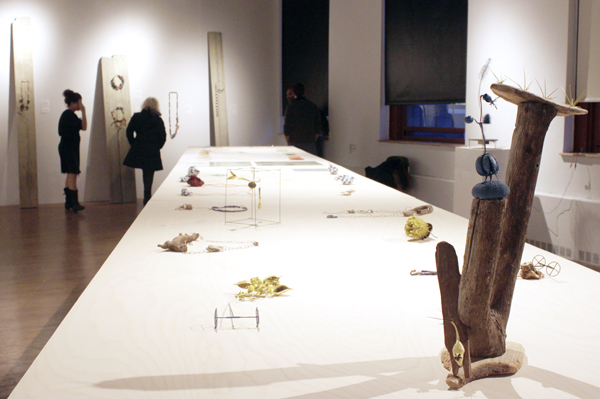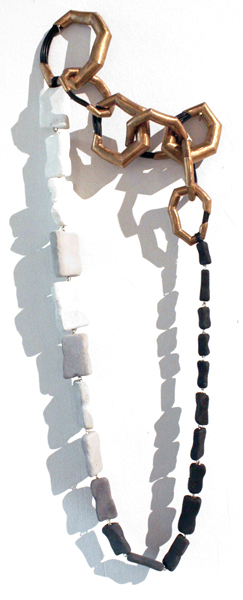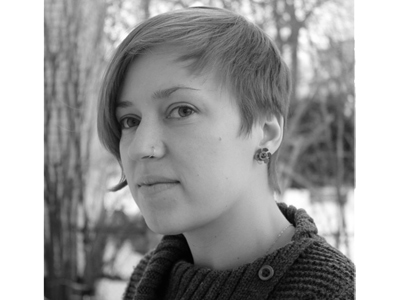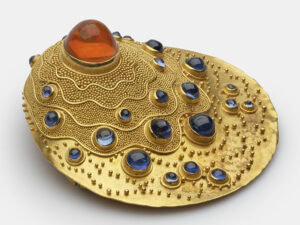
Beginning Middle Endless was born out of a desire to forge a connection between MassArt and Alchimia. Heather White, curator of the show and professor of the MassArt participants, collected the necklace halves from 40 students on two continents. She chose the compositions and assembled the resulting neckpieces. By joining the work of students who have never met, White set up a type of mock collaboration, showing students the unexpected possibilities that occur when they take risks. She praises the students’ role in the work, remarking that they engaged in an “act of blind faith” by turning their work over to another maker to be transformed by a new context. But White’s role in the creative process seems equally significant, as the neckpieces are just as much a product of her vision as that of her students. Choice is a force just as powerful as that of a rolling mill or a chasing hammer, a dictum supported by the fact that the most interesting parts of the work are the conversation between the two halves and the points of connection that merge them into one piece. It is easy to idealize moments of congruence that occur between these assembled half-necklaces. Some pieces are so similar in theme, technique, or underlying concept that they look as though they were conceived as a whole. But the moments of discontinuity in the work, of jarring uncertainty, are far more engaging and humorous than the pieces that appear whole.
For example, take the combination of Silhouette Chain by Sophie Hughes (MassArt) and Praise Chain by Sam Hamilton (Alchimia). Hughes’s chain is made of large, flat, sterling silver oval links that have been hammered and lightly patinated. This fairly traditional chain-making approach is paired with Hamilton’s Praise Chain, a length of chunky, graduated circular links made from acrylic and resin. The bulk of Hamilton’s half accentuates the paper-thin quality of Hughes’s material and the delicate marking on the surface. The use of precious metal in Hughes’s half makes the bubbling, riotous textural depth of Hamilton’s chain all the more playful. These necklaces combine not only materials, but also perspectives—perspectives on what jewelry is, and what it can be. What remains unclear is how many of these insights came from the makers and how many are the result of the curator’s input.

Collaboration is the key to the connection between the two halves of Beginning Middle Endless. While the student section of the show is typified by a set of curatorial decisions that mimic the results of collaboration, Dittlmann and Patterson’s section demonstrates the possibilities of a deeper form of creative cooperation. Seeing their individual work paired with their joint endeavors, we are able chart how their creative efforts work in tandem to complete a piece. In Dittlmann Wraps Patterson, Patterson collects natural objects into bundles and mails them to Dittlmann, who then swaddles each bundle in fabric and secures it with a Japanese ceremonial wrap. A string is passed through this new bundle to transform it into a pendant. Like Robert Rauchenberg’s Erased de Kooning drawing, this bundle simultaneously contains and conceals the meaning of Patterson’s contribution.

The lack of true collaboration between the students was disappointing. Although the curatorial combinations allow us to compare and contrast the ideas of two groups of students separated by thousands of miles, the most important possibility of this creative transaction is ultimately left unfulfilled. The give and take that occurs between artists working together is conspicuously absent from the student portion of the show. The decisions that drove the creation of the neckpieces were treated (rather confusingly) as chance occurrences rather than as calculated steps chosen to produce specific outcomes. Collaboration is process-oriented and driven by more than just the final product, and yet this process is surprisingly absent. With little explanatory text, we are left only with the objects to defend their existence.
The overall quality of the objects is admirable, as is White’s contribution as curator and matchmaker, but by far, the most exciting thing about Beginning Middle Endless is its sense of play and the willingness of its participants to take leaps. It is all the more unfortunate that the “encounter” between Italians and Americans and the difficult conversation that a collaboration implies did not actually take place. These encounters are powerful forces in the studio. They drive artists forward, giving them the courage to embrace change in their work. Despite all this, Beginning Middle Endless sends an instructive reminder to even the most seasoned maker—avoid the obvious solution.
Note from the editor:
Heather White, in an email to the editor, pointed out that the operative principle behind Beginning, Middle, Endless, is the cadavre exquis (exquisite corpse). Developed by the Surrealists in the 1920s, cadavre exquis consisted of poems composed by several authors. Each would write a few lines in turn without reading the lines preceding his or hers. Through this and other forms of automated writing, the Surrealists were trying to let a universal type of symbolism—or some hidden relationships—emerge from chance encounters between seemingly unrelated objects.
White’s matchmaking intervention is a clear departure from the cadavre exquis principle. One could even argue that having assembled the necklaces, she emerges as their co-author. However, she is keen to point out that the combination of unrelated necklace halves was not meant as collaboration. In line with the Surrealists, White was hoping to mine unexpected combinations, and perhaps more provocatively, to turn something unintentional into a curatorial bid, when so much in craft is about translating intention into objects.





